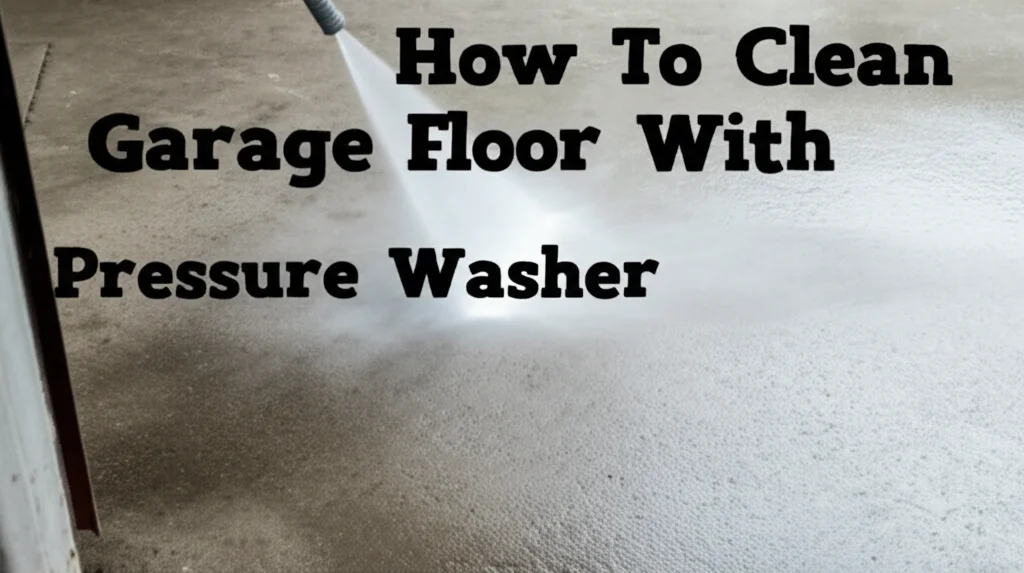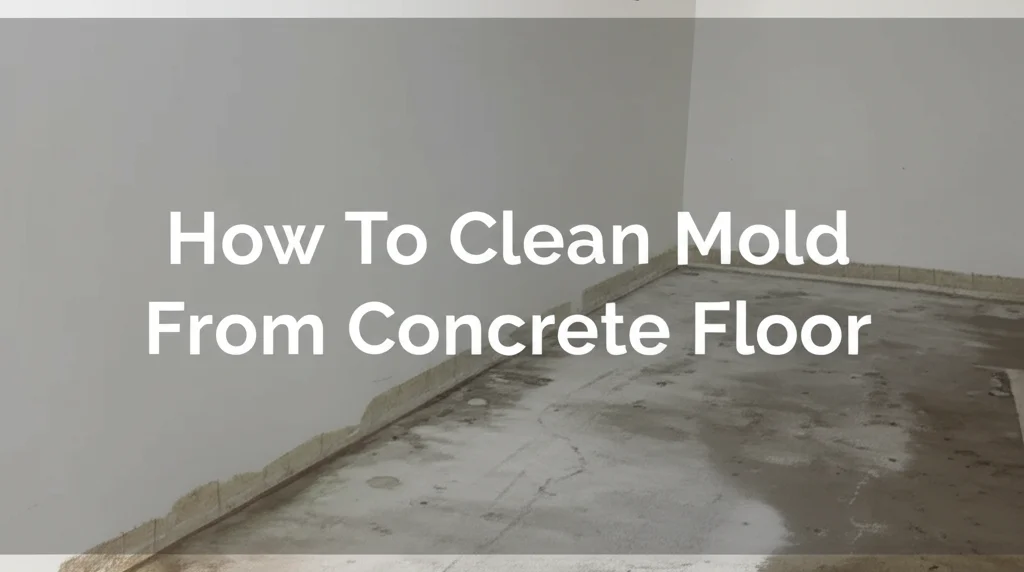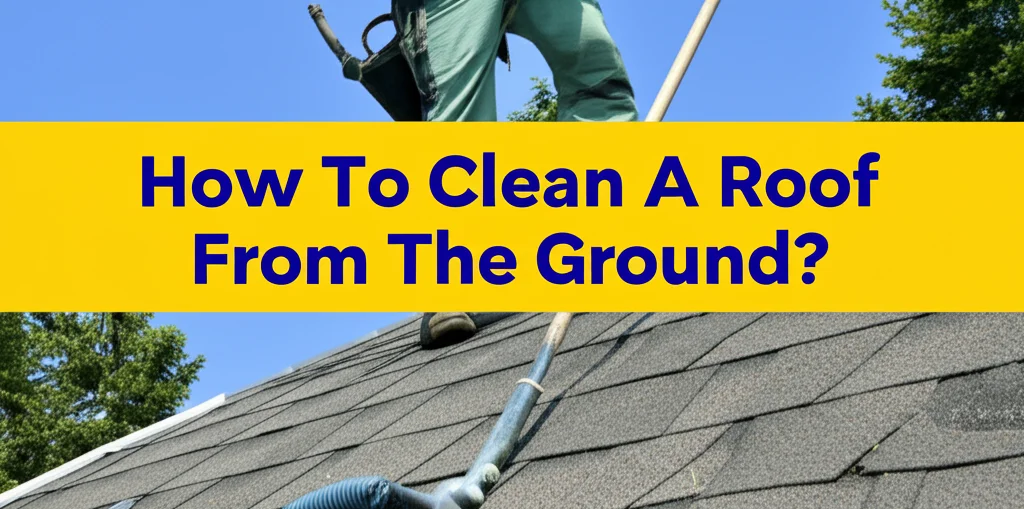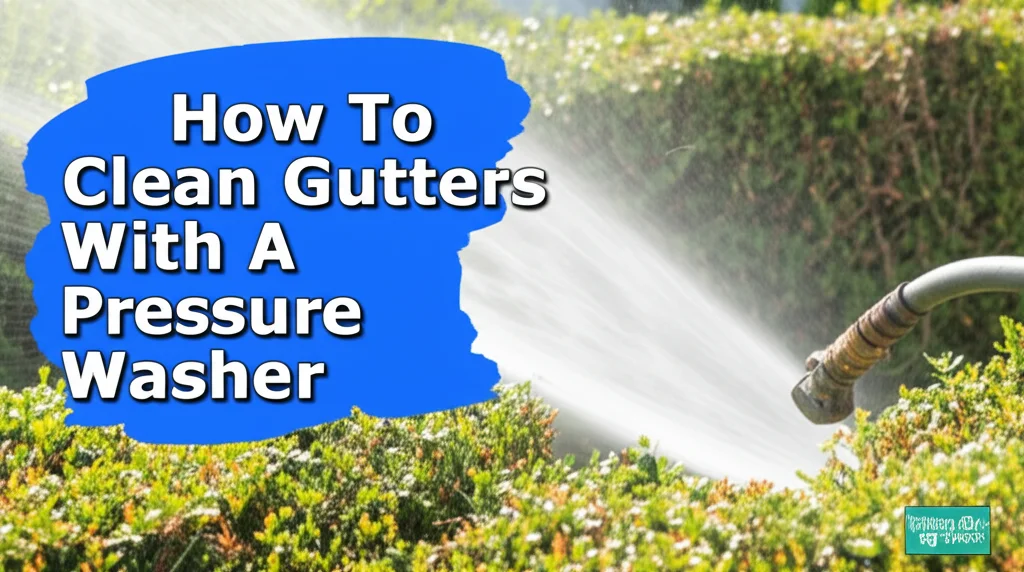· Home Improvement · 11 min read
How To Clean Garage Floor With Pressure Washer

How To Clean Garage Floor With Pressure Washer: The Ultimate Guide
A clean garage floor transforms your entire space, making it more inviting and functional. Over time, garage floors accumulate oil stains, dirt, grease, and various automotive fluids that can be challenging to remove with conventional cleaning methods.
Using a pressure washer offers a powerful solution to blast away years of accumulated grime and restore your concrete garage floor to its original condition. This comprehensive guide will walk you through everything you need to know about how to clean garage floor with pressure washer efficiently and effectively.
Whether you’re preparing your garage floor for a new coating, looking to remove stubborn stains, or simply want to refresh the space, pressure washing is the most effective method to achieve professional-grade results. We’ll cover everything from selecting the right equipment to proper techniques and aftercare to ensure long-lasting cleanliness.
Key Takeaways:
- Pressure washing your garage floor can remove tough stains, oil, and grime in a fraction of the time compared to manual scrubbing
- Select the right pressure washer (2000-3000 PSI) and attachments for concrete surfaces
- Prepare the garage properly by clearing the space and protecting walls and fixtures
- Apply the proper technique using a sweeping motion and maintain the right distance from the surface
- Follow up with appropriate sealing to protect your clean concrete from future stains
Why Pressure Wash Your Garage Floor?
Before diving into the process, it’s important to understand why pressure washing is the preferred method for cleaning concrete garage floors.
Benefits of Pressure Washing Garage Floors
Pressure washing your garage floor offers numerous advantages over traditional cleaning methods:
- Superior Cleaning Power: The high-pressure water stream effectively removes embedded dirt, oil, and grime that mops and brushes can’t touch.
- Time Efficiency: What might take hours of scrubbing can be accomplished in a fraction of the time with a pressure washer.
- Deep Cleaning: Pressurized water penetrates the porous surface of concrete, cleaning beyond just the surface layer.
- Environmentally Friendly: When used with appropriate detergents, pressure washing can be more eco-friendly than chemical-heavy alternatives.
- Preparation for Coatings: Creates an ideal clean surface if you plan to apply epoxy, paint, or sealants afterward.
Should You Pressure Wash a Garage Floor?
Absolutely! Pressure washing is ideal for concrete garage floors because concrete is durable enough to withstand the high pressure while being porous enough to benefit from deep cleaning. However, if your concrete is very old, cracked, or deteriorating, you’ll want to use a lower pressure setting to avoid causing damage.
For those wondering about alternatives, while manual cleaning is possible, it requires significantly more effort and typically delivers inferior results. How to clean vinyl plank flooring might be relevant for other areas of your home, but concrete garage floors benefit most from pressure washing.
Equipment and Materials Needed
Choosing the Right Pressure Washer
Selecting the appropriate pressure washer is crucial for effective garage floor cleaning:
- Recommended PSI: For concrete garage floors, look for a pressure washer with 2000-3000 PSI (pounds per square inch).
- Electric vs. Gas: Electric units are sufficient for occasional use, while gas-powered washers offer more power for tougher cleaning jobs.
- Water Flow Rate: A good flow rate (2-3 GPM, gallons per minute) ensures efficient cleaning.
Essential Accessories and Attachments
To maximize your pressure washing effectiveness, consider these helpful attachments:
- Surface Cleaner Attachment: This disk-shaped tool helps clean large flat surfaces more quickly and evenly than a standard nozzle.
- Various Nozzle Tips: Different spray patterns are useful for different cleaning stages.
- 15-degree: For stubborn stains
- 25-degree: For general cleaning
- 40-degree: For lighter cleaning and rinsing
- Extension Wand: Helps reduce back strain by allowing you to clean without bending.
- Rotating Brush: Useful for agitating particularly stubborn stains.
Cleaning Solutions and Degreasers
While water alone can clean effectively, specialized cleaning solutions enhance results:
- Concrete Cleaners: Specifically formulated for porous concrete surfaces.
- Degreasers: Essential for breaking down oil and automotive fluid stains.
- Trisodium Phosphate (TSP): Powerful cleaner for tough stains (use with proper protection).
- Eco-Friendly Options: Biodegradable cleaners that are effective yet environmentally responsible.
When dealing with specific types of tough stains, you might want to check out how to get grease out of carpet for techniques that can be adapted to concrete surfaces.
Preparation Steps Before Pressure Washing
Clearing and Organizing the Garage
Proper preparation ensures an efficient cleaning process:
- Remove all items from the garage, including vehicles, storage, tools, and equipment.
- Sweep away loose debris, dust, and dirt with a push broom.
- Cover immovable items with plastic sheeting to protect from splashing.
- Identify and mark areas with significant staining for special attention.
Protecting Walls, Fixtures, and Adjacent Areas
Pressure washers generate significant spray that can damage certain materials:
- Cover electrical outlets and fixtures with waterproof material.
- Apply painter’s tape around the edges of walls near the floor.
- Place towels or weatherstripping at the bottom of any interior doors.
- Consider using plastic sheeting or drop cloths on lower portions of drywall.
For those concerned about water damage in other areas of the home, understanding signs of mold under hardwood floors and how to remove it can be valuable knowledge.
Pre-Treating Tough Stains
For maximum effectiveness, pre-treat stubborn stains:
- Apply appropriate degreaser or stain remover to oil spots and tough stains.
- Allow the cleaner to sit for 10-15 minutes (or as directed on the product).
- Gently scrub with a stiff-bristled brush to loosen contaminants.
- Rinse lightly before beginning the main pressure washing process.
Step-by-Step Pressure Washing Process
Setting Up Your Pressure Washer
Proper setup ensures safety and effectiveness:
- Connect your garden hose to the pressure washer inlet.
- Attach the high-pressure hose to the washer outlet.
- Select and connect the appropriate nozzle (typically 25-degree to start).
- If using detergent, fill the soap reservoir with properly diluted solution.
- Place the pressure washer in a location where the electrical components won’t get wet.
- Test the pressure washer on an inconspicuous area to ensure appropriate pressure.
Proper Technique for Cleaning Concrete Floors
Using the correct technique maximizes cleaning power while minimizing damage:
- Start with the detergent application phase, using a low-pressure soap nozzle.
- Apply detergent in an even, overlapping pattern from one end of the garage to the other.
- Allow the detergent to dwell for 5-10 minutes but don’t let it dry completely.
- Switch to a higher-pressure nozzle (25-degree is typically ideal) for the cleaning phase.
- Hold the wand approximately 12-18 inches from the surface.
- Use smooth, overlapping sweeping motions, working in manageable sections.
- Clean in the direction of the floor drain or garage door opening.
- Pay special attention to heavily stained areas, possibly using a 15-degree nozzle carefully.
How to Pressure Wash Garage Floor Without Getting Walls Wet
This common concern has several effective solutions:
- Use a surface cleaner attachment, which significantly reduces splash.
- Attach splash guards or skirts to your pressure washer wand.
- Maintain control of the spray angle, directing it away from walls.
- Work in sections, starting from the center of the garage and moving outward.
- Consider using temporary barriers of plastic sheeting along walls.
For other difficult cleaning situations, like cleaning upstairs windows, check out how to clean outside windows upstairs for similar splash-control techniques.
Dealing with Specific Garage Floor Stains
Removing Oil and Grease Stains
Automotive fluids present special challenges:
- Apply a dedicated concrete degreaser or dish soap directly to the stain.
- Allow to soak for 15-20 minutes.
- Use a stiff brush to agitate the cleaner into the stain.
- Pressure wash using a concentrated spray pattern (15-degree nozzle).
- For stubborn stains, repeat the process or consider a poultice made with cat litter.
Addressing Rust and Chemical Stains
Different approach required for these challenging stains:
- For rust stains, apply a rust remover or oxalic acid solution.
- For chemical stains, identify the substance if possible and use an appropriate neutralizer.
- Allow the treatment solution to work for the recommended time.
- Pressure wash carefully, starting with lower pressure to avoid driving stains deeper.
- Repeat treatment as necessary.
Eliminating Mold and Mildew
Damp garage environments often promote mold growth:
- Mix a solution of one part bleach to four parts water.
- Apply to affected areas and let sit for 10-15 minutes.
- Pressure wash thoroughly, ensuring complete removal.
- Consider applying a mold inhibitor after the floor has dried completely.
Post-Cleaning Care and Maintenance
Proper Drying and Ventilation
After pressure washing, proper drying is crucial:
- Use a squeegee to direct excess water toward drains or the garage opening.
- Set up fans to increase air circulation and speed drying.
- Leave the garage door open for several hours if weather permits.
- Allow a minimum of 24-48 hours of drying time before returning items to the garage.
For those concerned about water damage, learning how to protect my garage floor from water can provide valuable insights.
Sealing Your Garage Floor After Cleaning
Protect your investment with an appropriate sealer:
- Ensure the floor is completely dry (typically 2-3 days after washing).
- Choose an appropriate concrete sealer based on your needs:
- Acrylic sealer for basic protection
- Epoxy coating for durability and aesthetics
- Polyurethane for chemical resistance
- Apply according to manufacturer directions, typically using a roller.
- Allow the recommended curing time before using the garage.
Regular Maintenance Tips to Keep Your Garage Floor Clean
Maintain your clean garage floor with these practices:
- Sweep weekly to prevent dirt accumulation.
- Spot clean spills immediately, especially automotive fluids.
- Apply absorbent materials like cat litter to fresh oil spills.
- Conduct a thorough cleaning every 6-12 months.
- Consider using floor mats in high-traffic areas and under vehicles.
Safety Considerations When Pressure Washing
Personal Protective Equipment
Safety should always be your priority:
- Eye protection/goggles to shield against debris and backsplash
- Closed-toe shoes or boots (preferably waterproof)
- Gloves to protect hands from chemicals and high-pressure water
- Ear protection if using a loud gas-powered pressure washer
- Respiratory protection when using chemicals in enclosed spaces
Electrical Safety Precautions
Mixing electricity and water requires careful attention:
- Use GFCI-protected outlets only
- Keep the pressure washer motor and electrical connections dry
- Never operate electrical equipment while standing in water
- Inspect cords for damage before each use
- Avoid using extension cords when possible
Chemical Handling and Environmental Considerations
Use cleaning solutions responsibly:
- Read and follow all manufacturer instructions
- Never mix cleaning chemicals
- Understand your local regulations regarding wastewater
- Consider using biodegradable and environmentally friendly cleaning solutions
- Prevent runoff from entering storm drains when possible
DIY vs. Professional Pressure Washing Services
When to Consider Hiring Professionals
While DIY pressure washing is achievable, sometimes professionals are the better choice:
- Extremely soiled garages with years of built-up grime
- Special circumstances like preparing for epoxy coating
- If you lack the necessary equipment
- When dealing with delicate or damaged concrete
- If you have physical limitations that make the job difficult
Cost Comparison: DIY vs. Professional Services
Understanding the financial aspects helps with decision-making:
- DIY costs: Pressure washer rental ($50-100/day) plus cleaning solutions ($20-50)
- Professional service: Typically $0.20-0.40 per square foot ($100-200 for average garage)
- Equipment purchase: $150-500 for consumer-grade pressure washer if planning regular use
- Value consideration: Time saved and potentially superior results with professionals
What to Look for When Hiring Pressure Washing Services
If choosing professional help, consider these factors:
- Insurance and bonding
- Experience specifically with garage floors
- Reviews and references
- Written estimates
- Guarantees or warranties on their work
- Environmentally responsible practices
Frequently Asked Questions
Should you pressure wash a garage floor?
Yes, pressure washing is highly effective for concrete garage floors. The high-pressure water can remove embedded dirt, oil stains, and grime that regular mopping cannot. Concrete is durable enough to withstand proper pressure washing, making it the ideal cleaning method for garage floors.
What is the best way to clean a dirty garage floor?
Pressure washing is the most effective method for thoroughly cleaning a dirty garage floor. For best results, clear the area completely, pre-treat oil stains with degreaser, use a pressure washer with 2000-3000 PSI, and apply an appropriate concrete cleaner. Follow up with a concrete sealer after drying to protect your clean floor.
How do you clean concrete with a pressure washer?
To clean concrete with a pressure washer, first sweep away loose debris and pre-treat stains. Apply concrete cleaner with the soap nozzle, let it sit for 5-10 minutes, then wash using a 25-degree nozzle. Work in systematic, overlapping passes while holding the wand 12-18 inches from the surface. Rinse thoroughly and allow to dry completely.
Should I use soap when pressure washing concrete?
Yes, using an appropriate concrete cleaner or degreaser enhances cleaning effectiveness. While water alone can remove surface dirt, specialized soaps break down oils and embedded grime. For garage floors with automotive stains, degreasers are particularly important. Always use cleaners specifically formulated for pressure washers and concrete surfaces.
What is the best solution for garage floors?
For cleaning, a concrete-specific cleaner or degreaser works best. For long-term protection after cleaning, consider applying an epoxy coating, which creates a durable, stain-resistant surface that’s easier to clean in the future. Polyurethane sealers offer excellent chemical resistance, while acrylic sealers provide basic protection at a lower cost.
What is the fastest way to clean a garage?
The fastest approach combines efficient organization with powerful tools: First, remove everything from the garage and sort items. Sweep thoroughly, then use a pressure washer with a surface cleaner attachment to clean the floor quickly. Focus special attention on stained areas, then use fans to speed drying. Apply a sealer for long-term cleanliness.
Final Words
Pressure washing your garage floor transforms this often-neglected space into a clean, functional area that enhances your entire home. The process of cleaning your garage floor with a pressure washer might require some effort, but the results are well worth it – a restored concrete surface free of years of accumulated dirt, grease, and stains.
With the right equipment, technique, and safety precautions, you can achieve professional-quality results. Remember that maintaining your clean garage floor through regular sweeping, prompt spill cleanup, and periodic resealing will extend the benefits of your deep cleaning effort.
Whether you choose the DIY approach or hire professionals, a clean garage floor creates a more pleasant and useful space that can increase your home’s value and functionality.
Take the time to properly prepare your space, use appropriate cleaning solutions, and follow up with protective sealing – your future self will thank you each time you step into your clean, fresh-smelling garage.




